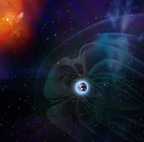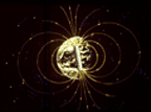|
|

|
 |
|
Magnetosphere |
 |
Artist's concept of the Sun-Earth connection.
|
The magnetosphere is a strong magnetic field that surrounds our planet. Acting as a shield, it deflects most solar energetic particle radiation that emanates from the Sun. For along with light, hot gases spew from the Sun and travel at a speed of a million miles an hour through space. They travel so fast that scientists call them collectively the "solar wind." As the hot gases of the solar wind approach Earth, they would singe our atmosphere if not for the magnetosphere. So, how does this shield work?
Magnetic fields deflect the motion of particles possessing a net electrical charge. When such charged particles encounter a magnetic field they experience something called the "Lorentz Force," which is directed at right angles to both the magnetic lines of force and the direction of motion of the particle. In very simple terms, think of using a bar magnet to push or move iron filings that are attracted by its magnetic field lines. In space this motion of
deflecting charged particles is important for technological reasons, such as controlling the beams of electrons that are used to create images on a television screen.
 |
Earth's Field Lines
|
The Earth, acting just like a very large magnet, also produces invisible lines of force, or magnetic field lines. Earth's field lines start near the South Pole of the Earth, curve around in space, and converge again near the North Pole, in what is called a "dipole ." Extending beyond Earth's Polar Regions, far out into space, these field lines form the magnetosphere, which deflects the Sun's ions and electrons before they reach us. So, most gaseous matter is pushed sideways around our planet, preventing it from hitting us head on.
However, Earth's magnetosphere is not unique. We have learned from our deep space probes that Jupiter, Saturn, Uranus, and Neptune are also magnetized, even more intensely than the Earth. Mars, however, has a weak magnetic field, Mercury has a small magnetsophere, and Venus appears to be unmagnetized. But, while Earth is not the only planet that is magnetized, it is the only one in our solar system that supports life as we know it.
|
|
|
|